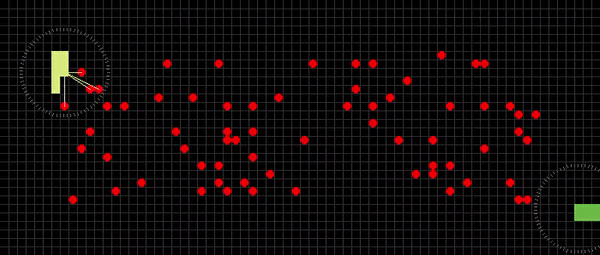Natural selection is a mechanism of evolution.
Organisms that are more adapted to their environment are more likely to survive and pass on the genes that aided their success.
This process causes species to change and diverge over time.
Natural selection is one of the ways to account for the millions of species that have lived on Earth.
For example, evolving long necks have enabled giraffes to feed on leaves that others can't reach, giving them a competitive advantage.
Thanks to a better food source, those with longer necks were able to survive. Those with shorter necks and access to less food would be less likely to survive.
 Giraffes with each other different genes
Giraffes with each other different genes
Let's do a simple simulation based on the basic concepts and understanding of natural selection.
First, we need to create an
environment and
populations that have the
genes to do so.
The worm will live in the environment that I created in a two-dimensional form, and the worm will have the following genes to survive to eat the feeds:
- speed: The moving speed of the worm
- sense: The distance for sensing feeds
- switch: The direction change probability (when there are no feeds within the distance for sensing)
I defined a class as below. Worms use the
moving function that interacts with genes to act.
class WormGene:
def __init__(self, speed: int, sense: float, switch: float) -> None:
self.speed = speed
self.sense = sense
self.switch = switch
class Worm(WormGene, WormHelper):
def __init__(
self,
speed: int = EnvironmentConsts.WORM_SPEED_ORIGINAL,
sense: float = EnvironmentConsts.WORM_SENSE_ORIGINAL,
switch: float = EnvironmentConsts.WORM_SWITCH_ORIGINAL
):
WormGene.__init__(self, speed, sense, switch)
self._initialize()
(...)
def moving(self, apples: List[Apple]) -> None:
self.direction: str
self.direction = self._get_random_direction(self.direction, self.switch)
nearest_apple = self._get_nearest_apple(self.body[-1], apples, self.sense)
if nearest_apple is not None:
self.direction = self._get_direction_by_sense(self.body[-1], nearest_apple, self.direction)
self.body: List[List[int]]
self.body = self._get_moved_body(self.body, self.direction, self.speed)
If you want to see the code for
Worm I defined, you can see it at the following link. And the environment, worms operate like the below Fig.2: An operation of the environment and worms.
Following whether the sensing circle the worm has contains apples, each worm will have a different operation method.
If apples are not within the sensing circle, worms determine the direction randomly by the
switch gene.
Else, calculate the angle between the worm's movement direction vector and the worm-to-apple vector, and calculate the difference between the angles to
select the vector with the highest similarity.
See the
code for detail of the worm's operation method
_get_direction_by_sense() and the method for finding the most similar direction to an apple is mathematically described as follows:
\( \mathbf{h} = (hx, hy)\) as the position of the worm's head
\( \mathbf{a} = (ax, ay)\) as the position of the nearest apple, adjusted by half the worm size to center on the apple
\( \mathbf{v}_{ha} = (a - h)\) as the vector from the worm's head to the apple
\( \theta_{ha} = arctan2(\mathbf{v}_{ha_y}, \mathbf{v}_{ha_x})\) as the angle in radians of \( \mathbf{v}_{ha}\)
\( \mathbf{U}\) as the set of unit vectors for possible movement directions, excluding the reverse of the current direction
\( \textit{D}\) as the set of corresponding movement directions
\( \theta_{u}\) as the angle in radians of each unit vector \(u \in U\)
\( \Delta\theta_{u, h_a} = | \theta_{ha} - \theta_{u} |\) as the absolute angular difference between \( \mathbf{v}_{ha} \) and each \(u\)
\( d_{\min} = \arg \min_{d \in D} (\Delta \theta_{u, ha})\)
 An operation of the environment and worms
An operation of the environment and worms
Now all preparations for the simulation are done. You can simulate natural selection as follows Fig.3: A part of the natural selection simulation
Let's fix the
generation,
population, and
seed for the reproducibility of natural selection simulations, and observe which genes survive.
Note that worms that do not eat even one
apple within one generation will die.
 A part of the natural selection simulation
A part of the natural selection simulation
I set the parameters for generation, population and seed as shown below. I then logged and visualized the results to observe how genes evolve and survive.
- generation: 100
- population: 50
- seed: 6
Let's see the visualized results. The x-axis is generation and the y-axis indicates each gene. And in the figure, I drew a line for
average genes per generation.
The set generation is 100, but it stopped at 70 generations. This is because only one worm survived after that generation.
The
Speed and
Sense genes tend to increase gradually over generations. Detecting apples and moving quickly to eat it will of course be advantageous to survival.
In the case of the
Switch gene, it started with 0.5, but the final evolved worm also returned to 0.5. In this environment, turning direction change too much seems to be against survival.
 Speed
Speed
 Sense
Sense
 Switch
Switch
Lastly, I will reproduce the data of the super worm that survived until the end in the environment and finish the post.
 Super worm! It's too fast...
Super worm! It's too fast...
Speed: 13
Sense: 450
Switch: 0.48